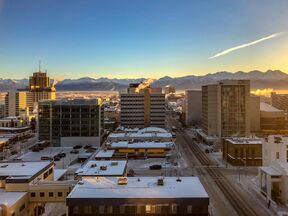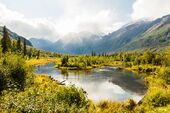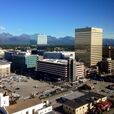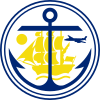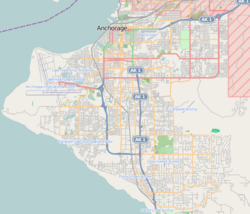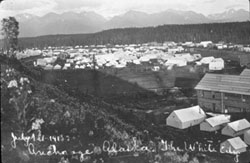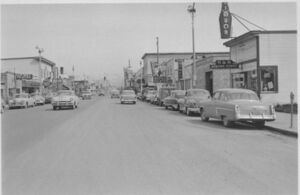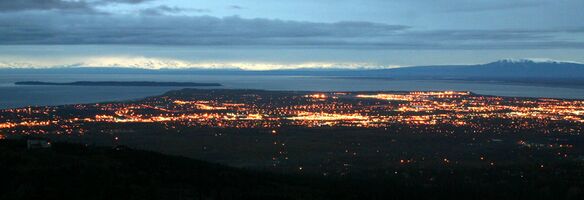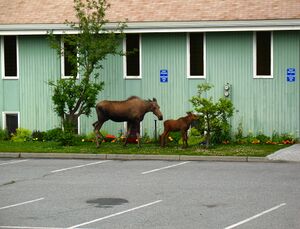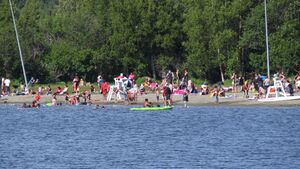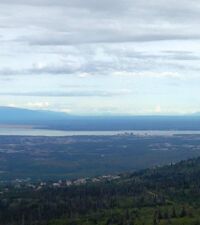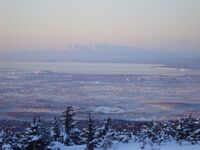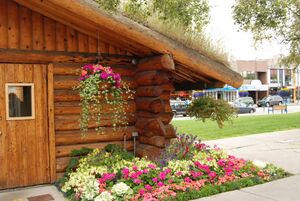أنكوردج، ألاسكا
بلدية أنكوردج
Anchorage, Alaska | |
|---|---|
بلدية | |
Downtown Anchorage in 2018 View from 5th Avenue Anchorage in 2006 Port of Anchorage in 1999 Anchorage Skyline with USS Anchorage departing | |
|
| |
| الكنية: The City of Lights and Flowers | |
| الشعار: Big Wild Life | |
 Interactive map of Anchorage | |
| الإحداثيات: 61°13′00″N 149°53′37″W / 61.21667°N 149.89361°W | |
| البلد | الولايات المتحدة |
| الولاية | ألاسكا |
| Borough | Anchorage |
| Settled | 1914 |
| Incorporated |
|
| السمِيْ | The anchorage at the mouth of Ship Creek |
| الحكومة | |
| • الكيان | Anchorage Assembly |
| • العمدة | Dave Bronson |
| • Alaska Senate | Senators
|
| • Alaska House | Representatives
|
| المساحة | |
| • بلدية | 1٬946٫69 ميل² (5٬041٫89 كم²) |
| • البر | 1٬706٫89 ميل² (4٬420٫81 كم²) |
| • الماء | 239٫80 ميل² (621٫08 كم²) |
| • الحضر | 78٫8 ميل² (204 كم²) |
| المنسوب | 102 ft (31 m) |
| التعداد | |
| • بلدية | 291٬247 |
| • Estimate (2022)[6] | 287٬145 |
| • الترتيب | |
| • الكثافة | 170٫6/sq mi (65٫88/km2) |
| • Urban | 249٬252 (US: 164th)[4] |
| • الكثافة الحضرية | 2٬718٫4/sq mi (1٬049٫6/km2) |
| • العمرانية | 398٬807 (US: 137th) |
| صفة المواطن |
|
| منطقة التوقيت | UTC-9 (AKST) |
| • الصيف (التوقيت الصيفي) | UTC-8 (AKDT) |
| ZIP code | 99501–99524, 99529–99530, 99599 |
| مفتاح الهاتف | 907 |
| جيوكود | 1398242 |
| FIPS code | 02-03000 |
| Climate | Dfc |
| الموقع الإلكتروني | www |
أنكوردج ( Anchorage ؛ Dena'ina: Dgheyay Kaq'; Dgheyaytnu)، هي مدينة موحدة تقع في ولاية ألاسكا, الولايات المتحدة. ووصل عدد سكانها إلى 291,247 نسمة في 2020 census,[5][7] it contains nearly 40 percent of the state's population, and has more people than all of Northern Canada and Greenland put together. The Anchorage metropolitan area, which includes Anchorage and the neighboring Matanuska-Susitna Borough, had a population of 398,328 in 2020,[8] accounting for more than half the state's population. At 1،706 sq mi (4،420 km2) of land area, the city is the fourth-largest by area in the United States and larger than the smallest state, Rhode Island, which has 1،212 sq mi (3،140 km2).[9]
Anchorage is in Southcentral Alaska, at the terminus of the Cook Inlet, on a peninsula formed by the Knik Arm to the north and the Turnagain Arm to the south.[10] First settled as a tent city near the mouth of Ship Creek in 1915 when construction on the Alaska Railroad began, Anchorage was incorporated as a city in November 1920.[11][12] In September 1975, the City of Anchorage merged with the Greater Anchorage Area Borough, creating the Municipality of Anchorage.[13] The municipal city limits span 1،961.1 sq mi (5،079.2 km2), encompassing the urban core, a joint military base,[14] several outlying communities, and almost all of Chugach State Park.[15] Because of this, less than 10% of the Municipality (or Muni) is populated, with the highest concentration of people in the 100 square-mile area that makes up the city proper, on a promontory at the headwaters of the inlet, commonly called Anchorage, the City of Anchorage, or the Anchorage Bowl.[16]
Due to its location, almost equidistant from New York City, Tokyo, and Frankfurt, Germany (across the Arctic Ocean), Anchorage lies within 10 hours by air of nearly 90% of the industrialized world.[17][18] For this reason, Ted Stevens Anchorage International Airport is a common refueling stop for international cargo flights and home to a major FedEx hub, which the company calls a "critical part" of its global network of services.[19][20]
Anchorage has won the All-America City Award four times: in 1956, 1965, 1984–85, and 2002, from the National Civic League.[21] Kiplinger has named it the United States' most tax-friendly city.[22]
التاريخ
Archaeological evidence discovered at Beluga Point just south of Anchorage proper, along the Turnagain Arm, suggests that habitation of the Cook Inlet began 5,000 years ago by a group of Alutiiq people who arrived by kayak. As this population moved on, they were followed by a second wave of Alutiiq occupation beginning roughly 4,000 years ago, followed by a third wave around 2,000 years ago. Around 500 AD the Chugach Alutiiq were displaced by the arrival of Dena'ina Athabaskans, who entered through the mountain passes. The Dena'ina had no fixed settlements, migrating throughout the area with the seasonal changes, fishing along coastal streams and rivers in the summer, hunting moose, mountain goats, and Dall sheep in early fall, and picking berries in late fall. They tended to winter near trading junctions along common travel routes, where they traded with other Dena'ina and Ahtna tribes from nearby areas.[23]
Captain James Cook was among the first European explorers to map the Alaskan coastline, and many of the geographical features (mountains, islands, rivers, waterways, etc.) still bear the names he gave them. Cook was searching for the fabled Northwest Passage, a route that would provide a shorter means of reaching the Pacific from Europe than the difficult Northeast Passage around the north of Asia, or south around South America. On May 15, 1778, after enduring weeks of hard weather, Cook turned into an inlet between two landmarks he called Cape Douglas and Mount St. Augustine. He anchored his ship, HMS Resolution, at a place he called "Anchor Point" (later named "Anchorage" as another Anchor Point existed to the south near Homer, Alaska), near a creek he dubbed "Ship Creek" nestled between two large arms (waterways). Cook spent ten days exploring the inlet named after him. He first sent William Bligh to scout the north arm, where he met with the Dena'ina Natives of the Eklutna area, who told him the name of the Knik Arm and that it was not the Northwest Passage, but rather an outlet for two rivers (the Knik and Matanuska Rivers). Cook then sailed south to scout the other arm, and in a bad mood after running the Resolution aground on a sandbar on his way back out of the shallow waters, called it "River Turnagain", having found no sign of the passage there either.[24]
In the 19th century, Russian presence in south-central Alaska was well-established. The Russians placed trading posts along Cook Inlet, such as the Shelikhov-Golikov Company's post at Niteh on the Palmer Flats (between the Knik and Matanuska Rivers), which in turn created small agricultural communities in Ninilchik, Seldovia, and Eklutna. The Russians also introduced diseases such as smallpox that had devastating effects on the local Native population, which plummeted by half just 10 years after the first census.[23]
In 1867, U.S. Secretary of State William H. Seward brokered a deal to purchase Alaska from Imperial Russia for $7.2 million, or about two cents an acre ($124.6 million in 2022 dollars). His political rivals lampooned the deal as "Seward's folly", "Seward's icebox" and "Walrussia". In 1888, gold was discovered along Turnagain Arm just south of modern-day Anchorage, leading to a new influx of prospectors, and small towns such as Spenard, Hope, Rainbow, Bird, Indian, and Girdwood began to spring up.
Alaska became an organized incorporated United States territory in 1912. Anchorage, unlike every other large town in Alaska south of the Brooks Range, was neither a fishing nor mining camp. The area surrounding Anchorage lacks significant economic metal ores. A number of Dena'ina settlements existed along Knik Arm for years. By 1911 the families of J. D. "Bud" Whitney and Jim St. Clair lived at the mouth of Ship Creek and were joined there by a young forest ranger, Jack Brown, and his bride, Nellie, in 1912.[25]
The city grew from its happenstance choice as a site for railroad construction to begin in 1914. The waters near Ship Creek were deep enough for barges and small ships to dock, and under the direction of Frederick Mears, it became a railroad-construction port for the Alaska Engineering Commission. The area near the mouth of Ship Creek, where the railroad headquarters was, quickly became a tent city. Anchorage formed at a time when proponents of Prohibition were gaining traction, and as part of an effort to stem the flow of the alcohol trade, at the direction of President Woodrow Wilson and with the symmetry of the US Army, a town site was mapped out on higher ground to the south of the tent city, with the condition that a person's land could be repossessed if caught breaking the alcohol laws.[23] Anchorage has been noted in the years since for its order and rigidity compared with other Alaska town sites.[12] In 1915, territorial governor John Franklin Alexander Strong encouraged residents to change the city's name to one that had "more significance and local associations".[26] In the summer of that year, residents held a vote to change the city's name; a plurality favored the name "Alaska City",[26] but the territorial government ultimately declined to change the city's name.[26] Anchorage was incorporated on November 23, 1920.[12]
Construction of the Alaska Railroad continued until its completion in 1923. The city's economy in the 1920s and 1930s centered on the railroad. Colonel Otto F. Ohlson, the Swedish-born general manager of the railroad for nearly two decades, became a symbol of residents' contempt due to the firm control he maintained over the railroad's affairs, which by extension became control over economic and other aspects of life in Alaska.
Between the 1930s and the 1950s, the city experienced massive growth as air transportation and the military became increasingly important. Aviation operations in Anchorage commenced along the firebreak south of town (today's Delaney Park Strip), which residents also used as a golf course. An increase in air traffic led to clearing of a site directly east of town site boundaries starting in 1929; this became Merrill Field, which served as Anchorage's primary airport during the 1930s and 1940s, until Anchorage International Airport superseded it in 1951. Merrill Field still sees a significant amount of general aviation traffic.
Elmendorf Air Force Base and the United States Army's Fort Richardson were constructed in the 1940s, and served as the city's primary economic engine until the 1968 Prudhoe Bay discovery shifted the thrust of the economy toward the oil industry.

The Good Friday earthquake of March 27, 1964, hit Anchorage hard at a magnitude of 9.2, killing 115 people and causing $116 million in damages ($750 million in 2022 dollars).[27][28][29] The earth-shaking event lasted nearly five minutes; most structures that failed remained intact for the first few minutes then failed with repeated flexing.[28][29] It was the world's fourth-largest earthquake in recorded history.[28][29] Broadcaster Genie Chance has been credited with holding Anchorage together, as she immediately rushed to the Anchorage Public Safety Building and stayed on the KENI airwaves for almost 24 continuous hours.[30] Chance, effectively designated as the public safety officer by the city's police chief,[31] was instrumental in Anchorage's relief and recovery efforts as she coordinated response efforts, connected urgent needs with available resources, disseminated information of available shelters and food sources, and passed messages among loved ones over the air, reuniting families.[30] Because the city and surrounding suburban area was built on top ground consisting of glacial silt, the prolonged shaking from the earthquake caused soil liquefaction, leading to massive cracks in roadways and collapse of large swaths of land. One of Anchorage's most affected residential areas, the Turnagain neighborhood, saw dozens of homes originally at 250 to 300 feet above sea level sink to sea level. Rebuilding and recovery dominated the remainder of the 1960s.
In 1968, ARCO discovered oil in Prudhoe Bay on the Alaska North Slope, and the resulting oil boom spurred further growth in Anchorage. In 1975, the City of Anchorage and the Greater Anchorage Area Borough (which includes Eagle River, Girdwood, Glen Alps, and several other communities) merged into the geographically larger Municipality of Anchorage[12] The city continued to grow in the 1980s, and capital projects and an aggressive beautification campaign took place.
Several attempts have been made to move Alaska's state capital from Juneau to Anchorage, or to a site closer to Anchorage. The motivation is straightforward: the "railbelt" between Anchorage and Fairbanks contains most of Alaska's population. Robert Atwood, owner of the Anchorage Times and a tireless booster for the city, championed the move. Alaskans rejected attempts to move the capital in 1960 and 1962, but in 1974, as Alaska's center of population moved away from Southeast Alaska and to the railbelt, voters approved it. Communities such as Fairbanks and much of rural Alaska opposed moving the capital to Anchorage for fear of concentrating more power in the state's largest city. As a result, in 1976, voters approved a plan to build a new capital city near Willow, about 70 mi (110 km) north of Anchorage. In the 1978 election, opponents to the move reacted by campaigning to defeat a nearly $1 billion bond issue to fund construction of the new capitol building and related facilities ($4 billion in 2022 dollars).. Later attempts to move the capital or the legislature to Wasilla, north of Anchorage, also failed.[32] Anchorage has over twice as many state employees as Juneau, and is to a considerable extent the center of Alaska's state and federal government activity.[بحاجة لمصدر]
الجغرافيا

Anchorage is in Southcentral Alaska. At 61 degrees north, it lies slightly farther north than Oslo, Stockholm, Helsinki and Saint Petersburg, but not as far north as Reykjavík or Murmansk. It is northeast of the Alaska Peninsula, Kodiak Island, and Cook Inlet, due north of the Kenai Peninsula, northwest of Prince William Sound and the Alaska Panhandle, and nearly due south of Denali.
The city is on a strip of coastal lowland and extends up the lower alpine slopes of the Chugach Mountains. Point Campbell, the westernmost point of Anchorage on the mainland, juts out into Cook Inlet near its northern end, at which point it splits into two arms. To the south is Turnagain Arm, a fjord that has some of the world's highest tides. Knik Arm, another tidal inlet, lies to the west and north. The Chugach Mountains on the east form a boundary to development, but not to the city limits, which encompass part of the wild alpine territory of Chugach State Park.
The city's sea coast consists mostly of treacherous mudflats. Newcomers and tourists are warned not to walk in this area because of extreme tidal changes and the very fine glacial silt. Unwary victims have walked onto the solid seeming silt revealed when the tide is out and have become stuck in the mud. The two recorded instances of this occurred in 1961 and 1988.[33]
According to the United States Census Bureau, the municipality has an area of 1,961.1 square miles (5,079.2 km2); 1,697.2 square miles (4,395.8 km2) of which is land and 263.9 square miles (683.4 km2) of it is water. The total area is 13.5% water.
Boroughs and census areas next to the Municipality of Anchorage are Matanuska-Susitna Borough to the north, Kenai Peninsula Borough to the south and Chugach Census Area to the east. The Chugach National Forest, a national protected area, extends into the southern part of the municipality, near Girdwood and Portage.
Cityscape
Wildlife
A diverse wildlife population exists within urban Anchorage and the surrounding area. Approximately 250 black bears and 60 grizzly bears live in the area. Bears are regularly sighted within the city. Moose are also a common sight; in the Anchorage Bowl, there is a summer population of approximately 250 moose, increasing to as many as 1,000 during the winter. They are a hazard to drivers, with over 100 moose killed by cars each year. Two people were stomped to death, in 1993 and 1995, in Anchorage.[34] Cross-country skiers and dog mushers using city trails have been charged by moose on numerous occasions; the Alaska Department of Fish and Game has to kill some individual aggressive moose in the city every year. Thinhorn sheep are often viewed quite close to the road at Windy Point.[35] Approximately thirty northern timber wolves reside in the Anchorage area. In 2007, several dogs were killed by timber wolves while on walks with their owners.[36][37] There are also beaver dams in local creeks and lakes, and sightings of foxes and kits in parking lots close to wooded areas in the spring are common. Along the Seward Highway headed toward Kenai, there are common sightings of beluga whales in the Turnagain Arm. Lynxes are occasionally sighted in Anchorage as well. Within the Municipality there are also a number of streams that host salmon runs. Fishing for salmon at Ship Creek next to downtown is popular in the summer.
المناخ
| Anchorage | ||||||||||||||||||||||||||||||||||||||||||||||||||||||||||||
|---|---|---|---|---|---|---|---|---|---|---|---|---|---|---|---|---|---|---|---|---|---|---|---|---|---|---|---|---|---|---|---|---|---|---|---|---|---|---|---|---|---|---|---|---|---|---|---|---|---|---|---|---|---|---|---|---|---|---|---|---|
| جدول الطقس (التفسير) | ||||||||||||||||||||||||||||||||||||||||||||||||||||||||||||
| ||||||||||||||||||||||||||||||||||||||||||||||||||||||||||||
| ||||||||||||||||||||||||||||||||||||||||||||||||||||||||||||
Anchorage has a subarctic climate (Köppen climate classification: Dfc) but with strong maritime influences that lead to a relatively moderate climate.[39] Most of its precipitation falls in late summer. Average daytime summer temperatures range from approximately 55 إلى 78 °F (13 إلى 26 °C); average daytime winter temperatures are about 5 إلى 30 °F (−15.0 إلى −1.1 °C). Anchorage has a frost-free growing season that averages slightly over 101 days. According to local folklore, when a native plant called fireweed goes to seed after a full bloom, the first snowfall of winter is 6 weeks away.[40]
Average January low and high temperatures at Ted Stevens Anchorage International Airport (ANC) are 11 إلى 23 °F (−12 إلى −5 °C) with an average winter snowfall of 75.5 in (192 cm).[41] The 2011–2012 winter had 134.5 in (341.6 cm), which made it the[42] snowiest winter on record, topping[42][43] the 1954–1955 winter with 132.8 in (337.3 cm). The coldest temperature ever recorded at the original weather station at Merrill Field on the East end of 5th Avenue was −38 °F (−38.9 °C) on February 3, 1947.[nb 1]
Summers are mild (although cool compared to the contiguous US and even interior Alaska), and it can rain frequently, although not abundantly. Average July low and high temperatures are 52 إلى 66 °F (11 إلى 19 °C) and the highest reading ever recorded was 90 °F (32.2 °C) on July 4, 2019.[44] The average annual precipitation at the airport is 16.63 in (422 mm).[41] Anchorage's latitude causes summer days to be very long and winter daylight hours to be very short. The city is often cloudy during the winter, which further decreases the amount of sunlight experienced by residents.[45]
The coldest daily maximum recorded in Anchorage is −19 °F (−28 °C) in January 1989, while the coldest daily maximum on average between 1991 and 2020 was at 1 °F (−17 °C).[41] Warm summer nights do not occur even with the bayside location and extensive daylight. The mildest night on record is at 63 °F (17 °C) and the normal mean is at 59 °F (15 °C).[41]
Due to its proximity to active volcanoes, ash hazards are a significant, though infrequent, occurrence. The most recent notable volcanic activity centered on the multiple eruptions of Mount Redoubt during March–April 2009, resulting in a 25،000 ft (7،600 m) high ash cloud as well as ash accumulation throughout the Cook Inlet region. Previously, the most active recent event was an August 1992 eruption of Mount Spurr, which is 78 mi (126 km) west of the city.[46] The eruption deposited about 3 mm (0.1 in) of volcanic ash on the city. The clean-up of ash resulted in excessive demands for water and caused major problems for the Anchorage Water and Wastewater Utility.
The average temperature of the sea ranges from 35.8 °F (2.1 °C) in February to 53.1 °F (11.7 °C) in August.[47] قالب:Anchorage weatherbox
| بيانات المناخ لـ Campbell Airstrip (Anchorage Alaska) | |||||||||||||
|---|---|---|---|---|---|---|---|---|---|---|---|---|---|
| الشهر | ينا | فب | مار | أبر | ماي | يون | يول | أغس | سبت | أكت | نوف | ديس | السنة |
| متوسط القصوى اليومية °ف (°س) | 20 (−7) |
26 (−3) |
35 (2) |
45 (7) |
58 (14) |
66 (19) |
68 (20) |
65 (18) |
55 (13) |
41 (5) |
26 (−3) |
22 (−6) |
44 (7) |
| متوسط الدنيا اليومية °ف (°س) | 2 (−17) |
4 (−16) |
9 (−13) |
22 (−6) |
33 (1) |
41 (5) |
47 (8) |
44 (7) |
35 (2) |
22 (−6) |
7 (−14) |
5 (−15) |
23 (−5) |
| متوسط هطول الثلج inches (cm) | 10.0 (25) |
16.0 (41) |
18.0 (46) |
9.0 (23) |
0.2 (0.51) |
0.0 (0.0) |
0.0 (0.0) |
0.0 (0.0) |
0.0 (0.0) |
9.0 (23) |
11.0 (28) |
2.0 (5.1) |
75.2 (191.61) |
| Source: NOAA[41] | |||||||||||||
الديموغرافيا
| التعداد | Pop. | ملاحظة | %± |
|---|---|---|---|
| 1920 | 1٬856 | — | |
| 1930 | 2٬277 | 22٫7% | |
| 1940 | 3٬495 | 53٫5% | |
| 1950 | 11٬254 | 222�0% | |
| 1960 | 44٬397 | 294٫5% | |
| 1970 | 48٬081 | 8٫3% | |
| 1980 | 174٬431 | 262٫8% | |
| 1990 | 226٬338 | 29٫8% | |
| 2000 | 260٬283 | 15�0% | |
| 2010 | 291٬826 | 12٫1% | |
| 2020 | 291٬247 | −0٫2% | |
| 2022 (تق.) | 287٬145 | [48] | −1٫4% |
| U.S. Decennial Census[49][50] | |||
Anchorage first appeared on the 1920 U.S. Census.[51] It incorporated that same year and In 1975 it was consolidated with its borough.
According to the 2020 census, Anchorage had a population of 291,247.[7] Its racial makeup was 63.8% White (57.1% were non-Hispanic or Latino), 10.0% Asian, 9.1% American Indian or Alaska Native, 9.4% were Hispanic or Latino, 6.0% were African American and 8.4% were from two or more races. 6.9% of the population were under the age of 5, 24.0% were under the age of 18, 64.3% were between 18 and 64, and 11.7% were 65 years or over. 50.9% of the population were male and 49.1% were female. 9.3% were veterans and 10.9% of the population was born outside of the United States. There were 119,276 housing units, 106,567 households and the average household size was 2.69 people per household. 17.8% of households had a language other than English spoken at home. 95.9% of households had a computer present with 90.0% having a broadband Internet connection. 93.9% of the population had a high school diploma or higher with 36.1% having a Bachelor's degree or higher. 8.4% of the population under the age of 65 had a disability with 11.1% of the same age group having no health insurance. 68.5% of the population were in the civilian labor force. The median household income was $84,928 and the per capita income from May 2019–April 2020 was $41,415. The poverty rate was 9.5%.
Languages
In 2010, 83.7% (220,304) of Anchorage residents aged five and older spoke only English at home, while 4.5% (11,769) spoke Spanish, 2.5% (6,654) Tagalog, 1.6% (4,108) various Pacific Island languages, 1.4% (3,636) various Native American/Alaska Native languages, 1.1% (2,994) Korean, 0.6% (1,646) German, 0.6% (1,502) Hmong, 0.5% (1,307) Russian, and Japanese was spoken as a main language by 0.5% (1,185) of the population over the age of five. In total, 16.3% (43,010) of Anchorage's population aged five and older spoke a mother language other than English.[52]
اعتبارا من 7 سبتمبر 2006[تحديث], 94 languages were spoken by students in the Anchorage School District.[53]
من أهم المساجد في آلاسكا مسجد الرشيد في مدينة أنكوردج والمركز الإسلامي في نفس المدينة.
الاقتصاد
Anchorage's largest economic sectors include transportation, military, municipal, state and federal government, tourism, corporate headquarters (including regional headquarters for multinational corporations) and resource extraction. Large portions of the local economy depend on Anchorage's geographical location and surrounding natural resources. Anchorage's economy traditionally has seen steady growth, though not quite as rapid as many places in the lower 48 states. With the notable exception of a real estate-related crash in the mid-to-late 1980s, which saw the failure of numerous financial institutions, it does not experience as much pain during economic downturns.[بحاجة لمصدر]
The Ted Stevens Anchorage International Airport (TSAIA) is the world's fourth busiest airport for cargo traffic, surpassed only by Memphis, Hong Kong, and Shanghai Pudong. This traffic is strongly linked to Anchorage's location along great circle routes between Asia and the lower 48. In addition, the airport has an abundant supply of jet fuel from in-state refineries in North Pole and Kenai. This jet fuel is transported to the Port of Anchorage, then by rail or pipeline to the airport.
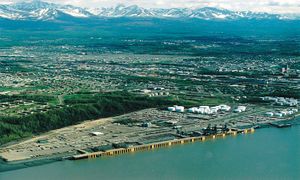
The Port of Anchorage receives 95 percent of all goods destined for Alaska. Ships from Totem Ocean Trailer Express and Horizon Lines arrive twice weekly from the Port of Tacoma in Washington. Along with handling these activities, the port is a storage facility for jet fuel from Alaskan refineries, which is used at both TSAIA and Joint Base Elmendorf-Richardson (JBER).
The existing port was substantially built in the late 1950s and is reaching the end of its useful life. Beginning in 2017, the Port of Anchorage is undertaking an extensive 7-year Anchorage Port Modernization Project[54] to upgrade its aging infrastructure, support larger deeper draft vessels, and future proof the port seismically and environmentally for another 75 years.
The United States military has two large installations, Elmendorf Air Force Base and Fort Richardson, which originally stemmed from the branching off of the U.S. Air Force from the U.S. Army following World War II. In a cost-cutting effort initiated by the 2005 BRAC proceedings, the bases were combined. JBER was created, which also incorporated Kulis Air National Guard Base near TSAIA. The combination of these three bases employ approximately 8,500 civilian and military personnel. These individuals along with their families comprise approximately ten percent of the local population. During the Cold War, Elmendorf became an important base due to its proximity to the Soviet Union, particularly as a command center for numerous forward air stations established throughout the western reaches of Alaska (most of which have since closed).
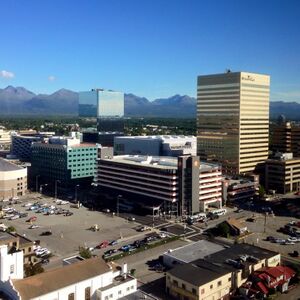
While Juneau is the official state capital of Alaska, more state employees reside in the Anchorage area. Approximately 6,800 state employees work in Anchorage compared to about 3,800 in Juneau. The State of Alaska purchased the Bank of America Center (which it renamed the Robert B. Atwood Building) to house most of its offices, after several decades of leasing space in the McKay Building (now the McKinley Tower) and later the Frontier Building.
The resource sector, mainly petroleum, is arguably Anchorage's most visible industry, with many high-rise buildings bearing the logos of large multinationals such as Hilcorp and ConocoPhillips. While field operations are centered on the Alaska North Slope and south of Anchorage around Cook Inlet, the majority of offices and administration are found in Anchorage. The headquarters building of ConocoPhillips Alaska, a subsidiary of ConocoPhillips, is in downtown Anchorage.[55] It is also the tallest building in Alaska. Many companies who provide oilfield support services are likewise headquartered outside of Anchorage but maintain a substantial presence in the city, most notably Arctic Slope Regional Corporation and CH2M Hill.
Four small airlines, Alaska Central Express,[56] Era Aviation,[57] Hageland Aviation Services,[58] and PenAir, are headquartered in Anchorage.[59] Alaska Airlines (at one point headquartered in Anchorage, but now headquartered in the Seattle area), has major offices and facilities at TSAIA, including the offices of the Alaska Airlines Foundation.[60] Prior to their respective dissolutions, airlines MarkAir, Reeve Aleutian Airways and Wien Air Alaska were also headquartered in Anchorage.[61][62][63] The Reeve Building, at the corner of West Sixth Avenue and D Street, was spared the wrecking ball when the city block it sits on was cleared to make way for the Anchorage 5th Avenue Mall, and was incorporated into the mall's structure. In 2013, Forbes named Anchorage among its list of Best Places for Business and Careers.[64]
Five Alaska Native regional corporations are based in Anchorage: The Aleut Corporation, Bristol Bay Native Corporation, Calista Corporation, Chugach Alaska Corporation, and Cook Inlet Region, Inc.
Anchorage does not levy a sales tax. However, it charges a 12% bed tax on hotel stays and an 8% tax on car rentals.[65] Since about 2000, in response to strong revenue and occupancy rates, major hotel developers from the Lower 48 have been building new hotels along C Street from International Airport Road to just north of Tudor Road, with two more to open in 2017, making this half-mile stretch of C Street a new "hotel row".[66] From Anchorage people can easily head south to popular fishing locations on the Kenai Peninsula or north to locations such as Denali National Park and Fairbanks.
الفنون
Located next to Town Square Park in downtown Anchorage, the Alaska Center for the Performing Arts is a three-part complex that hosts numerous performing arts events each year. The facility can accommodate more than 3,000 people. In 2000, nearly 245,000 people visited 678 public performances. It is home to eight resident performing arts companies and has featured mega-musicals performed by visiting companies. The center also hosts the International Ice Carving Competition as part of the Fur Rendezvous festival in February.
The Anchorage Concert Association brings 20 to 30 events to the community each year, including Broadway shows like Disney's The Lion King, Les Misérables, Mamma Mia!, The Phantom of The Opera, West Side Story, and others. The Sitka Summer Music Festival presents an "Autumn Classics" festival of chamber music for two weeks each September on the campus of Alaska Pacific University. Orchestras include the Anchorage Symphony Orchestra and the Anchorage Youth Symphony.
Annually in January, the Anchorage Folk Festival takes place at the University of Alaska Anchorage, featuring concerts, dances, and workshops with featured guest artists and over 130 performances by volunteer singers, dancers, musicians, and storytellers.
- Alaska Native Heritage Center[67]
- Alaska Museum of Natural History[68]
- Alaska Aviation Heritage Museum
- Anchorage Museum at Rasmuson Center[69]
- Oscar Anderson House Museum[70]
- Wells Fargo Alaska Heritage Library & Museum[71]
The city of Anchorage provides three municipal facilities large enough to hold major events such as concerts, trade shows and conventions. Downtown facilities include the Alaska Center for the Performing Arts, William A. Egan Civic & Convention Center and the recently completed Dena'ina Civic and Convention Center, which will be connected via skybridge to form the Anchorage Civic & Convention District. The Sullivan Arena hosts sporting events as well as concerts and annual trade shows.
الحكومة والسياسة
| Year | Office | Results |
|---|---|---|
| 2010 | Senator | Murkowski 42–32% |
| House | Young 65–34% | |
| Governor | Parnell 57–41% | |
| 2012 | President | Romney 53–43% |
| House | Young 61–32% | |
| 2014 | Senator | Begich 48–47% |
| House | Young 47–46% | |
| Governor | Walker 49–45% | |
| 2016 | President | Trump 47–42% |
| Senator | Murkowski 45–25% | |
| House | Young 48–40% | |
| 2018 | House | Galvin 51–49% |
| Governor | Begich 48–48% | |
| 2020 | President | Biden 49–47% |
| Senator | Sullivan 50–47% | |
| House | Galvin 51–49% |
Anchorage is governed by an elected mayor and 11-member assembly, with the assistance of a city manager. These positions are nonpartisan (as are all municipal elected offices in Alaska): no candidates officially run under any party banner. All 11 members are elected from districts known as sections. Five of the sections elect two members from designated seats, while the remaining section elects one member. Before the 1980 United States Census, the single-member section was the one centered around the northern Anchorage communities of Chugiak and Eagle River. Since then, the area encompassing Downtown Anchorage and surrounding neighborhoods has served as the city's single-member section. The mayor (along with members of the school board) is elected in a citywide vote. In practice, major candidates' party affiliation and political ideology are usually well known and highlighted by local media for the purpose of framing debate. The city's mayor is Dave Bronson. Along with seven sister cities in the SCI program[مطلوب توضيح], Anchorage has a cultural exchange program with Montenegro.
In the 2017 municipal election, Christopher Constant and Felix Rivera became the first openly gay candidates elected to Anchorage public office.[72][73]
Anchorage generally leans toward Republican candidates in both state and presidential elections. But since the establishment of the municipality in 1975, there have been two Democratic mayors (Tony Knowles and Mark Begich), each of whom was elected to two consecutive terms and later to statewide office. Downtown, Girdwood, and much of both the west and east parts of town trend Democratic. Areas closest to the military bases, including Eagle River, and south Anchorage are the municipality's most Republican areas. Midtown is relatively moderate. In 2020, Joe Biden became the first Democrat to win Anchorage since Lyndon Johnson in 1964.
| السنة | الجمهوري | الديمقراطي | حزب ثالث | |||
|---|---|---|---|---|---|---|
| رقم. | % | رقم. | % | رقم. | % | |
| 2020 | 68,169 | 46٫97% | 70,933 | 48٫87% | 6,031 | 4٫16% |
| 2016 | 61,066 | 46٫97% | 53,953 | 41٫50% | 14,999 | 11٫54% |
| 2012 | 66,430 | 53٫06% | 54,026 | 43٫15% | 4,745 | 3٫79% |
| 2008 | 76,959 | 56٫91% | 55,221 | 40٫84% | 3,040 | 2٫25% |
| 2004 | 76,807 | 59٫93% | 47,676 | 37٫20% | 3,681 | 2٫87% |
| 2000 | 67,959 | 57٫15% | 34,726 | 29٫20% | 16,235 | 13٫65% |
| 1996 | 51,627 | 52٫79% | 32,638 | 33٫37% | 13,538 | 13٫84% |
| 1992 | 45,253 | 41٫38% | 32,889 | 30٫07% | 31,227 | 28٫55% |
| 1988 | 50,508 | 61٫16% | 29,412 | 35٫62% | 2,659 | 3٫22% |
| 1984 | 60,987 | 68٫70% | 25,158 | 28٫34% | 2,627 | 2٫96% |
| 1980 | 38,956 | 59٫10% | 15,186 | 23٫04% | 11,774 | 17٫86% |
| 1976 | 31,884 | 61٫46% | 17,136 | 33٫03% | 2,857 | 5٫51% |
| 1972 | 23,918 | 63٫31% | 10,859 | 28٫74% | 3,003 | 7٫95% |
| 1968 | 13,833 | 45٫10% | 13,005 | 42٫40% | 3,831 | 12٫49% |
| 1964 | 9,051 | 40٫07% | 13,537 | 59٫93% | 0 | 0�00% |
| 1960 | 11,119 | 53٫71% | 9,581 | 46٫29% | 0 | 0�00% |
Voting trends show that Downtown Anchorage votes Democratic in large margins, while Spenard, Turnagain/Inlet View, and University/Airport Heights are relatively moderate and swing in elections. The remaining Anchorage areas have traditionally trended Republican.[75] In 2018, Anchorage began conducting municipal elections by mail (as directed by the assembly in 2015) and had the highest voter turnout in the city's history.[76]
Anchorage-Eagle River sends 16 representatives (اعتبارا من 2018[تحديث], nine Republicans and seven Democrats) to the 40-member Alaska House of Representatives and eight senators (five Republicans and three Democrats) to the 20-member Senate. When seats from the neighboring Mat-Su Borough are added, more than half the Alaska state legislature comes from the Anchorage metropolitan area. This is often used as an argument for moving the state capital from Juneau to the Anchorage area.
Public safety

With a reported strength of 383 sworn officers, the Anchorage Police Department is the largest police department in the state, serving an area of 159 square miles with a population of 300,950.[77] Until 2016, Alaska State Troopers provided policing for the southern regions of Anchorage along Turnagain Arm. After their withdrawal, Girdwood contracted with the neighboring city of Whittier for its policing,[78] and the following year APD provided contract policing to other Turnagain Arm communities.[79] The Fire & EMS Operations Division of the Anchorage Fire Department (AFD) includes thirteen fire stations with over 300 personnel covering three rotating 24-hour shifts. Additionally, there are volunteer fire departments in Girdwood and Chugiak and fire departments on Elmendorf Air Force Base and Fort Richardson, as well as the Airport Police and Fire Department.[80]
| Violent crimes[nb 2] per 100,000 pop. |
Property crimes[nb 3] per 100,000 pop. | |
|---|---|---|
| Anchorage[81] | 837.7 | 3,518.0 |
| Alaska[82] | 638.8 | 2,852.5 |
| U.S. cities, pop. 100,000–249,999[83] |
519.6 | 3,846.8 |
| U.S. cities, pop. 250,000–499,999[83] |
757.7 | 4,216.6 |
| U.S. total[82] | 403.6 | 2,941.9 |
Source: FBI Uniform Crime Reports
| ||
In 2010, Anchorage reported 837.7 violent crimes per 100,000 population and 3,518.0 property crimes per 100,000 population (see table). Anchorage's crime rate, both for violent and property crimes, is higher than for Alaska as a whole or for the U.S. as a whole. When compared with U.S. cities of similar size, Anchorage has a slightly higher rate of violent crime and a slightly lower rate of property crime. Anchorage, and Alaska in general, have very high rates of sexual assault in comparison with the rest of the country, with Anchorage's annual rate of forcible rapes over three times as high as for the U.S. as a whole. In 2010, the rate of rape for Anchorage was 90.9 per 100,000 population,[81] while the U.S. rate was 27.5 per 100,000 population.[82] Alaska Natives are victimized at a much higher rate than their representation in the population.[84]
The Anchorage Community Survey, a public survey conducted in 2004–05 by the Justice Center at University of Alaska Anchorage, found that overall, Anchorage residents are fairly satisfied with the performance of the Anchorage Police Department.[85] Most survey respondents perceived the justice system to be "somewhat effective" or "very effective" at apprehending and prosecuting criminal suspects, bringing about just outcomes, and reducing crime.[86]
المدن الشقيقة
| مدن شقيقة[87] |
|---|
انظر أيضاً
- Anchorage Fire Department
- "Anchorage" by singer Michelle Shocked.
- List of aerospace museums
- List of tallest buildings in Anchorage
- National Register of Historic Places listings in Anchorage, Alaska
ملاحظات
- ^ In an average winter, the first snow happens in mid-October and begins to thaw in mid-March, but snow can sometimes be present until the end of April. The high temperature would usually drop below freezing at the beginning of November. The average first frost happens during the first half of September and the average last frost happens during the second half of May. In March 2002, a record snow storm, 26.7 inches, hit Anchorage."Temperature Records for Anchorage Alaska" (PDF). National Oceanic and Atmospheric Administration. Archived from the original (PDF) on February 20, 2013. Retrieved April 1, 2012.
- ^ Includes of murder and nonnegligent manslaughter, forcible rape, robbery, and aggravated assault.
- ^ Includes burglary, larceny-theft, motor vehicle theft, and arson.
المصادر
- ^ Cochran, Jessica. "Alaska Cultural Connections: Los Anchorage". Archived from the original on March 15, 2017. Retrieved March 14, 2017.
- ^ Cole, Dermot (September 25, 2011). "'Los Anchorage' may seem a world apart, but it's not alien territory". Fairbanks Daily News-Miner. Archived from the original on September 29, 2018. Retrieved March 15, 2018.
- ^ "2020 U.S. Gazetteer Files". United States Census Bureau. Archived from the original on October 28, 2021. Retrieved October 29, 2021.
- ^ "List of 2020 Census Urban Areas". census.gov. United States Census Bureau. Retrieved January 7, 2023.
- ^ أ ب "Explore Census Data". United States Census Bureau. Retrieved January 14, 2023.
- ^ "City and Town Population Totals: 2020-2021". United States Census Bureau. January 14, 2023. Retrieved January 14, 2023.
- ^ أ ب "U.S. Census Bureau QuickFacts Anchorage Municipality (County), Alaska; Anchorage municipality, Alaska". United States Census Bureau. Retrieved January 14, 2023.
- ^ "2020 Census Data - Cities and Census Designated Places" (Web). State of Alaska, Department of Labor and Workforce Development. Archived from the original on October 31, 2021. Retrieved October 31, 2021.
- ^ Jegede, Abayomi (July 2, 2021). "Top 10 Largest Cities in USA by Land Area". Trendrr. Archived from the original on January 14, 2019. Retrieved August 21, 2021.
- ^ "Alaska Geography". Archived from the original on October 18, 2014.
- ^ Naske, Claus-M. (1987). Alaska: A History of the 49th State (in الإنجليزية). University of Oklahoma Press. p. 7. ISBN 978-0-8061-2573-2.
- ^ أ ب ت ث "Community Database Online, Anchorage". Alaska Division of Community and Regional Affairs. Archived from the original on March 24, 2012. Retrieved July 4, 2011.
- ^ "Municode Library". Archived from the original on August 24, 2021. Retrieved August 24, 2021.
- ^ Fulton, William; Daniels, Jessica; de la Peña, Benjamin (2008). "Case Studies in Smart Growth Implementation – Anchorage, Alaska" (PDF). Smart Growth Leadership Institute. Archived from the original (PDF) on March 4, 2016. Retrieved January 9, 2015.
- ^ State of Alaska. "Chugach State Park, Alaska State Parks". alaska.gov. Archived from the original on August 14, 2015. Retrieved October 18, 2015.
- ^ "Anchorage Bowl Land Use Plan Map – Anchorage Bowl Comprehensive Plan – Community Discussion Draft 2/29/16" (PDF). Municipality of Anchorage. Archived (PDF) from the original on March 16, 2016. Retrieved October 13, 2021.
- ^ "Anchorage Int'l Airport Serves as Pit Stop for Global Cargo Carriers – Airport Improvement Magazine". airportimprovement.com. Archived from the original on February 6, 2017. Retrieved February 6, 2017.
- ^ "Iceland airline's 'over the top' flights will connect Alaska to Europe". Archived from the original on August 24, 2021. Retrieved August 24, 2021.
- ^ "Latest Global News" (PDF). About FedEx. Archived (PDF) from the original on October 30, 2013. Retrieved October 18, 2015.
- ^ "Alaskan airport set to be the new stopover between Europe and Asia-Pacific". Independent.co.uk. February 9, 2021. Archived from the original on August 24, 2021. Retrieved August 24, 2021.
- ^ "National Civil League All-America winners by state". National Civic League. Archived from the original on December 4, 2010. Retrieved July 2, 2008.
- ^ "Top 10 Tax-Friendly Cities". Kiplinger. April 24, 2007. Archived from the original on February 24, 2016. Retrieved February 15, 2016.
- ^ أ ب ت Aunt Phil's Trunk: Bringing Alaska's history alive! Volume 3 by Laurel Bill, Phyllis Carlson – Aunt Phil's Trunk LLC 2016 pp. 1–5
- ^ Captain Cook: Master of the Seas by Frank McLynn, Yale University Press, 2011قالب:ISBN?[صفحة مطلوبة]
- ^ A Gathering of Saints in Alaska: an informal chronicle of the Church of Jesus Christ of Latter-day Saints in the state of Alaska. Alaska: The Church of Jesus Christ of Latter-day Saints. 1983. p. 306.
- ^ أ ب ت Jones, Preston (2010). City for Empire: An Anchorage History, 1914–1941. University of Alaska Press. pp. 169–70. ISBN 978-1602230859. Archived from the original on August 17, 2016. Retrieved February 22, 2016.
- ^ "Tsunami Events Full Search, sort by Date, Country". ngdc.noaa.gov. National Geophysical Data Center. Archived from the original on August 25, 2017. Retrieved November 25, 2017.
- ^ أ ب ت "The Great Alaska Earthquake of 1964". Geophysical Institute, UAF. Alaska Earthquake Information Center. Archived from the original on April 7, 2012. Retrieved July 4, 2011.
- ^ أ ب ت "Historic Earthquakes, Prince William Sound, Alaska". USGS. Archived from the original on August 25, 2009. Retrieved July 4, 2011.
- ^ أ ب "Genie Chance and the Great Alaska Earthquake". The New York Times (in الإنجليزية الأمريكية). May 22, 2020. ISSN 0362-4331. Archived from the original on November 25, 2020. Retrieved December 4, 2020.
- ^ "When a Quake Shook Alaska, a Radio Reporter Led the Public Through the Devastating Crisis". Smithsonian Magazine (in الإنجليزية). Archived from the original on November 15, 2020. Retrieved December 4, 2020.
- ^ "Alaska History and Cultural Studies – Governing Alaska – The Capital of Alaska". akhistorycourse.org. Archived from the original on January 17, 2016. Retrieved October 18, 2015.
- ^ Kaniut, Larry (1999). Danger Stalks the Land: Alaskan Tales of Death and Survival. St. Martins Press. pp. 2–6, 287–91. ISBN 978-1466824898. Archived from the original on July 26, 2020. Retrieved March 15, 2018.
- ^ "Moose Stomps Man to Death on College Campus". Associated Press. Archived from the original on December 15, 2013. Retrieved December 5, 2013.
- ^ "Alaska Highway Drives from Anchorage". Alaska.org. Archived from the original on September 20, 2010. Retrieved August 31, 2010.
- ^ "Alaska Dept. of Fish and Game, Living with Wildlife in Anchorage: a Cooperative Planning Effort". State of Alaska. April 2000. Archived from the original on January 5, 2008. Retrieved February 8, 2008.
- ^ "North Side wolf pack attacks, kills dogs". Anchorage Daily News. December 11, 2007. Archived from the original on October 19, 2008. Retrieved February 8, 2008.
- ^ "U.S. Climate Data". Archived from the original on July 26, 2020. Retrieved May 7, 2020.
- ^ "Climate". Archived from the original on July 31, 2018. Retrieved July 31, 2018.
- ^ "Fireweed: Countdown to Winter". Human Flower Project. Archived from the original on October 29, 2014. Retrieved October 29, 2014.
- ^ أ ب ت ث ج خطأ استشهاد: وسم
<ref>غير صحيح؛ لا نص تم توفيره للمراجع المسماةNOWData NWS Anchorage, AK (PAFC) ANCthr - ^ أ ب "Record-breaking Snowfall in Anchorage". ktuu.com. April 7, 2012. Archived from the original on April 8, 2012. Retrieved 9 June 2012.
- ^ "Snowfall Records for Anchorage Alaska" (PDF). National Oceanic and Atmospheric Administration. Archived from the original (PDF) on February 20, 2013. Retrieved April 1, 2012.
- ^ Alaska Bakes with Alltime Heat Records Archived مارس 7, 2016 at the Wayback Machine
Weather Underground. June 21, 2013. Retrieved January 20, 2016 - ^ "For November, December, and January, average monthly percent possible sunshine (the hours of direct sunlight experienced, divided by the possible hours of sunlight for the location) is below 35%". Climate.umn.edu. Archived from the original on October 19, 2012. Retrieved October 15, 2012."For an explanation of the concept "percent possible sunlight". Data Through 2005 Average Percent Possible Sunshine at National Climatic Data Center. Archived from the original on June 17, 2008. Retrieved November 20, 2006.
- ^ "Mt. Spurr's 1992 Eruptions". Alaska Volcano Observatory. Archived from the original on December 9, 2008. Retrieved November 26, 2008.
- ^ "Anchorage Water Temperature – United States – Sea Temperatures". World Sea Temperatures. Archived from the original on July 5, 2017. Retrieved June 4, 2017.
- ^ "Annual Estimates of the Resident Population for Counties: April 1, 2020 to July 1, 2022". Retrieved April 13, 2023.
- ^ "U.S. Decennial Census". Census.gov. Archived from the original on April 26, 2015. Retrieved June 30, 2013.
- ^ Moffatt, Riley. Population History of Western U.S. Cities & Towns, 1850–1990. Lanham: Scarecrow, 1996, 1. ISBN 978-0810830332
- ^ "Population" (PDF). U.S. Decennial Census 1920. United States Census Bureau. p. 544. Archived (PDF) from the original on August 17, 2017. Retrieved August 21, 2021.
- ^ "Anchorage Municipality County, Alaska". Modern Language Association. Archived from the original on August 15, 2013. Retrieved August 10, 2013.
- ^ "About the Anchorage School District – Languages our students speak". ASD Online – Anchorage School District. Archived from the original on December 19, 2008. Retrieved April 1, 2009.
- ^ "Anchorage Port Modernization Project". portofanc.com. Archived from the original on March 16, 2017. Retrieved January 21, 2017.
- ^ "North Slope National Petroleum Reserva Alaska 2008/2009 Exploration Drilling Program Archived سبتمبر 19, 2010 at the Wayback Machine." ConocoPhillips Alaska. November 2008. Page 1 (1/8). Retrieved February 14, 2010.
- ^ "Contact Us Archived يونيو 14, 2010 at the Wayback Machine." Alaska Central Express. Retrieved January 24, 2010.
- ^ "Contact Us Archived أغسطس 14, 2010 at the Wayback Machine." Era Aviation. Retrieved July 16, 2009.
- ^ "Contact Us Archived نوفمبر 9, 2009 at the Wayback Machine." Hageland Aviation Services. Retrieved November 3, 2009.
- ^ "Contact Us Archived ديسمبر 21, 2008 at the Wayback Machine." PenAir. Retrieved July 16, 2009.
- ^ "The Alaska Airlines Foundation Archived مارس 28, 2010 at the Wayback Machine." Alaska Airlines. Retrieved February 27, 2010.
- ^ "World Airline Directory." Flight International. March 22–28, 1995. 761 Archived مارس 3, 2012 at the Wayback Machine.
- ^ "World Airline Directory." Flight International. March 30, 1985. 111 Archived مارس 3, 2012 at the Wayback Machine." Retrieved July 23, 2009.
- ^ "About Us". Archived from the original on August 27, 1999. Retrieved April 13, 2017.
{{cite web}}: CS1 maint: bot: original URL status unknown (link) Reeve Aleutian Airways. August 27, 1998. Retrieved July 23, 2009. - ^ "Best Places For Business and Careers – Forbes". Forbes. Archived from the original on August 8, 2013. Retrieved January 16, 2014.
- ^ "Alaska Taxable 2008" (PDF). Alaska Department of Commerce, Community, and Economic Development. January 2009. Archived from the original (PDF) on June 21, 2009. Retrieved February 24, 2010.
- ^ "'Hotel Row' springs up in Midtown Anchorage, updated September 28, 2016". Alaska Dispatch News. Archived from the original on February 2, 2017. Retrieved January 21, 2017.
- ^ "Alaska Native Heritage Center". Alaskanative.net. Archived from the original on April 3, 2007. Retrieved January 29, 2012.
- ^ "Alaska Museum of Natural History". Alaskamuseum.org. Archived from the original on January 30, 2012. Retrieved January 29, 2012.
- ^ "The Anchorage Museum at Rasmuson Center". Anchoragemuseum.org. Archived from the original on March 3, 2021. Retrieved January 29, 2012.
- ^ "anchoragehistoric.org". anchoragehistoric.org. Archived from the original on June 23, 2011. Retrieved January 29, 2012.
- ^ Alaskan Heritage Museum Archived أغسطس 7, 2012 at the Wayback Machine Wells Fargo. Retrieved August 10, 2012.
- ^ [1] Archived أبريل 6, 2017 at the Wayback Machine HuffPost, "Two Openly Gay Candidates Notch Historic Wins in Alaska Election". Retrieved April 6, 2017.
- ^ [2] Archived أبريل 7, 2017 at the Wayback Machine KTVA, "Anchorage voters elect first openly gay assembly members". Retrieved April 6, 2017.
- ^ Elections, RRH (February 2, 2018). "RRH Elections". rrhelections.com. Archived from the original on January 29, 2020. Retrieved January 12, 2020.
- ^ "2008 Presidential Election Results by House District in Alaska". USA Election Atlas. Retrieved July 5, 2010.
- ^ Kelly, Devin. "Anchorage's vote-by-mail election was supposed to boost turnout. It shattered a record". Anchorage Daily News. Archived from the original on January 19, 2021. Retrieved March 14, 2019.
- ^ "Table 78 (Alaska). Full-Time Law Enforcement Employees by State by City, 2008.". Retrieved December 11, 2009. Archived سبتمبر 24, 2009 at the Wayback Machine
- ^ "Municipality, Whittier agree to interim Girdwood police contract". Alaska Dispatch News. Archived from the original on May 17, 2018. Retrieved May 15, 2018.
- ^ "Turnagain Arm Police Service Area Begins". Glacier City Gazette. Archived from the original on May 17, 2018. Retrieved May 15, 2018.
- ^ Anchorage Fire Department Archived مارس 7, 2007 at the Wayback Machine official website. Retrieved April 2, 2007.
- ^ أ ب Federal Bureau of Investigation. (2010). "Table 8 (Alaska). Offenses Known to Law Enforcement." Archived مارس 13, 2016 at the Wayback Machine Uniform Crime Reports. FBI. Retrieved August 10, 2012.
- ^ أ ب ت Federal Bureau of Investigation. (2010). "Table 4. Crime in the United States, by Region, Geographic Division, and State, 2009–2010." Archived مايو 29, 2016 at the Wayback Machine Crime in the United States 2010. Archived يونيو 26, 2016 at the Wayback Machine. Retrieved August 10, 2012.
- ^ أ ب Federal Bureau of Investigation. (2010). "Table 16. Rate: Number of Crimes per 100,000 Inhabitants by Population Group, 2005." Archived يونيو 26, 2016 at the Wayback Machine. Retrieved August 10, 2012.
- ^ Rosay, André. (Winter 2004). "Forcible Rapes and Sexual Assaults in Anchorage." Archived يونيو 17, 2008 at the Wayback Machine Alaska Justice Forum 20(4): 1, 9–11. Retrieved April 2, 2007.
- ^ Myrstol, Brad A. (Summer 2005). "Making the Grade? Public Evaluation of Police Performance in Anchorage." Archived أبريل 11, 2012 at the Wayback Machine Alaska Justice Forum 22(2): 5–10. Retrieved August 10, 2012.
- ^ Justice Center, University of Alaska Anchorage. (Fall 2005). "Anchorage Attitudes Toward Justice System." Archived يونيو 17, 2008 at the Wayback Machine Alaska Justice Forum 22(3): 8.
- ^ "Home > Sister Cities > Homepage". Municipal of Anchorage. Retrieved 2007-10-12.
وصلات خارجية
| أنكوردج, ألاسكا
]].- Pages using gadget WikiMiniAtlas
- مقالات بالمعرفة بحاجة لذكر رقم الصفحة بالمصدر from October 2021
- CS1 الإنجليزية الأمريكية-language sources (en-us)
- CS1 maint: bot: original URL status unknown
- Short description is different from Wikidata
- Articles with hatnote templates targeting a nonexistent page
- Pages using multiple image with auto scaled images
- Coordinates on Wikidata
- Pages using infobox settlement with image map1 but not image map
- Articles containing Tanaina-language text
- Articles with unsourced statements from November 2015
- مقالات فيها عبارات متقادمة منذ سبتمبر 2006
- جميع المقالات التي فيها عبارات متقادمة
- Articles with unsourced statements from May 2023
- جميع الصفحات التي تحتاج تنظيف
- مقالات بالمعرفة تحتاج توضيح from January 2017
- مقالات فيها عبارات متقادمة منذ 2018
- Pages with empty portal template
- Portal-inline template with redlinked portals
- مدن في ألاسكا
- مدن مستقلة في الولايات المتحدة
- أنكوردج، ألاسكا
- مدن تأسست سنة 1914
- مدن موانئ في الولايات المتحدة
- أنكوردج الكبرى
- Anchorage metropolitan area
- Cities in Alaska
- Alaska boroughs
- Consolidated city-counties
- Populated coastal places in Alaska on the Pacific Ocean
- Port cities in Alaska
- Populated places established in 1914
- 1914 establishments in Alaska
- صفحات مع الخرائط
